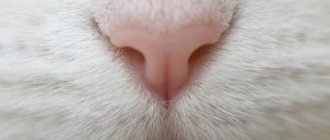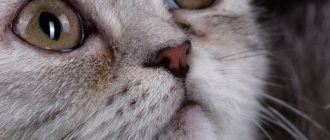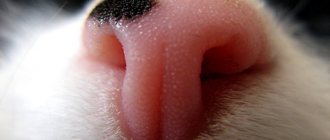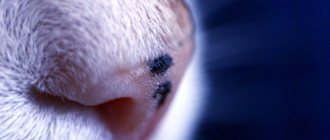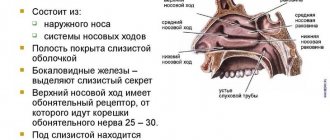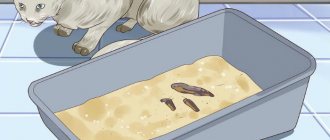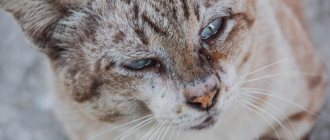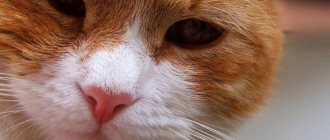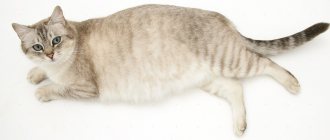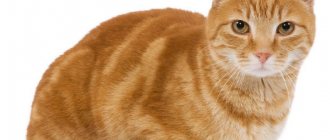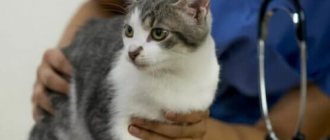Cat's wet nose
A cat's wet nose is an indicator of normality and good health. On the surface of the nose there are glands that secrete a secretion (a special liquid) that helps to more clearly recognize odors. The secretion covers the outer layer with a thin layer. Volatile substances that carry odor are attracted to a wet nose like a magnet. On inhalation, with the flow of air, they enter the mucous membrane, where receptors recognize the meaning of the aroma.
There are situations when the nose becomes very wet. It may even drip liquid. This is not a good sign. It may indicate rhinitis, allergies or viral infections.
How can you tell if your cat is sick?
A healthy animal has a cool, slightly moist nose. The disease usually manifests itself with an increase in temperature. But this doesn't always happen. Why does a cat have a cold and wet nose when he is sick?
It is impossible to determine the cause of the pathology by one sign, because such a symptom can occur:
- with decreased immunity;
- viral infection;
- cold;
- allergies.
© shutterstock
If a cat is sick, his behavior changes:
- appetite decreases;
- lethargy appears;
- he sneezes and snorts;
- often rubs his face with his paw.
The temperature may be elevated even if the cat has a cold and wet nose. A hot ear on the inside is a sign of hyperthermia. To clarify the indicator, a thermometer is used, as when measuring temperature in people.
It is difficult to determine the temperature of the earlobe, because it can be dry and warm after sleep, prolonged play, or during emotional excitement. However, if this condition persists for several hours and the cat is depressed, then it is necessary to show him to the veterinarian.
The cat has a dry nose
A cat's dry nose does not always symbolize illness. In order to understand this process, let's return to the physiology of the cat's body.
Another task of the released watery secretion is thermoregulation. The absence of sweat glands on the body and dense fur forced the cat’s body to look for other ways to cool down. The sweat glands are located on the paws, and the nose takes on only part of the functions. Under the influence of dry air and high ambient temperatures, moisture evaporates from the cat's respiratory system, thereby taking away excess heat. At this moment, the nose may be dry, but the cat periodically licks itself, replenishing the supply of evaporated fluid. This starts the cooling process again.
A common case of normal dry nose in cats is during and after sleep. During sleep, the body works in economical mode. The nasal glands stop producing secretions, and the nose dries out. After waking up, it should take 15 to 30 minutes before the nasal glands are fully operational.
A similar condition of dry nose in cats and kittens is observed after active games or hunting.
If your mustachioed pet is active and cheerful, you don’t have to worry about his health. If the cat is lethargic and sleepy, has no appetite or thirst, you should be wary. An additional indicator of health will be nasal temperature and thermography (measuring body temperature with a thermometer).
When to worry
Signs of disease appear differently in cats. Frequent symptoms:
- Frequent or infrequent trips to the toilet.
- Diarrhea with blood.
- Frequent stress, nervous tension.
- The fur falls out.
- Nausea.
- Deep breaths.
The condition changes several times a day; after waking up, the dry earlobe is normally moisturized within 2-3 hours.
The combination of symptoms indicates a weak immune system; high-quality food is used to strengthen it. Dry foods cause dehydration, organ function deteriorates, experts advise combining the daily intake of dry mixture with simple food. Cats are predatory animals that require meat; good nutrition normalizes the functioning of organs, strengthens the immune system, increases resistance to disease, and pets tolerate external influences better.
The temperature of the earlobe is checked with the back of the palm - carefully so as not to hit or scare the cat. Attention is shown to the four-legged behavior, appearance, and conditions of detention.
Viral immunodeficiency is detected in 13% of sick pets. Elderly and oldest cats that constantly walk outside are at risk. FIV is transmitted through saliva after bites from sick animals.
Associated symptoms:
- Weight is lost.
- Diarrhea.
- Profuse lacrimation.
- Heat.
Symptoms of FIV are rare, the initial form develops without signs, the temperature does not change, and nasal discharge appears.
Prohibited actions:
- The earlobe should not be wiped with alcohol wipes or antibacterial solutions to avoid allergies.
- Iodine and brilliant green are not used for disinfection when scratches appear. Therapy is determined by the veterinarian after examination; self-medication leads to negative consequences.
The cat has a hot nose
The main thing is not to panic!
In cats, a hot nose can become either due to physiological (natural) reasons or due to a malfunction of the body.
Physiological cases:
- Dry nose (after and during sleep, after running)
- warm air in the apartment (hot summer days or the pet spends a lot of time near the radiator in winter)
- Thirstiness or dehydration (always make sure your cat has plenty of water available)
Pathology:
- Lethargy and loss of appetite
- Dull coat
- Strange behavior
- Other signs of disease
If you suspect that your cat is sick, never rely solely on the nose, but measure the temperature with a thermometer. If it changes, immediately make an appointment with a veterinary clinic!
When there is no reason to worry
Speaking about what the nose of a healthy cat should be like, it should be noted that situational changes in its temperature and humidity are not always a direct sign of the presence or development of any disease in the animal. Thus, the nose of kittens is often hotter than the nose of an adult animal.
Also, any kind of stress, increased physical activity and even ordinary sleep make it dry and hot, which, however, does not in any way affect the pet’s health.
What are the signs that require contacting a veterinarian?
If the following symptoms are detected in a kitten, you should consult a veterinarian to identify the causes of your pet’s illness:
- malaise, lethargy, apathy;
- dry and hot nose;
- cold and pale nose;
- change in organ color (blue, yellowish, red, white).
The owner should know that a pale and cold organ in a kitten is a sign of:
- chronic illness;
- hypothermia;
- stress;
- low body temperature;
- poisoning;
- complete lack of appetite.
A white and warm nose is a sign of a disruption in the kitten’s circulatory system. The blue and hot organ talks about:
- heart failure;
- inflammation of the respiratory organs;
- oxygen starvation.
When a kitten has a hot and red organ, this is a sign:
- infectious disease;
- rhinitis;
- mechanical damage.
If a kitten has a hot, dry nose and warm ears, then this is not necessarily a sign of illness, because heat exchange has not yet been established in babies, and their body temperature is higher than that of an adult pet. This may be due to the work of the body and its protection from hypothermia.
Dangerous causes of warm and dry nose
If none of the previously listed reasons apply, a warm nose may indicate an illness in your pet. You can roughly determine it by the symptoms, although you should consult a doctor to make an accurate diagnosis.
Fever is one of the symptoms of the following diseases:
- neoplasms in the nasal sinuses, or something may simply get stuck in them;
- injuries due to which secretion production decreases or stops;
- rhinitis, sinusitis;
- various types of inflammation and infectious diseases;
- diseases of the urinary system;
- gastrointestinal upset due to overeating;
- poisoning;
- trichobezoars in the stomach or intestines;
- tick infestation.
If you suspect that the cause of a warm nose is something from this list, you should show your pet to a doctor. The sooner the disease can be identified and treatment begun, the lower the likelihood of complications.
The main reasons why a kitten's nose may become dry
First you need to consider the natural (physiological) reasons why a kitten’s nose may become dry:
- As mentioned above, the nose of a sleeping or actively playing animal will almost always be dry. This is normal, no need to worry.
- If it is very hot and stuffy indoors or outdoors, the nose will dry out very quickly and will only become moist after placing the animal in normal conditions.
- Stress factors (fear, pregnancy, childbirth, etc.) also contribute to drying out of this part of the body.
- Experienced breeders know that it is rare for old and very old pets to have a normally moistened nose. This is due to a general slowdown in the animal’s metabolism and activity. As in the cases described above, it is not a pathology (as a rule).
Pathological causes of dry skin on the nose:
- Any infectious diseases accompanied by an increase in general body temperature, as well as fevers of any type.
- Poisoning.
- Some parasitic diseases. In this case, severe intoxication develops, as in the previous case.
- Dryness may have nothing to do with the general condition of the body and its temperature. This sign often indicates dermatological diseases (dermatitis, eczema, fungal pathologies). In these cases, there are ulcers, cracks, and other types of sores on the nose. • Foreign bodies in the respiratory tract. • Sometimes the nose becomes dry when allergic reactions develop.
Structure of a cat's nose
The cat's nose is not very different in structure from the noses of other mammals. He has:
- 2 nostrils;
- two nasal passages called choanae;
- cavities;
- labyrinth of lattice shells.
The nose is devoid of fur and has a unique skin pattern, akin to human fingerprints.
The skin pattern on a cat's nose is strictly individual.
The cat's nose has an interesting assistant - Jacobson's organ (vomeronasal organ). It is located in the animal's mouth, on the palate. Consists of two small, liquid-filled sacs. Using the palatal canals, it connects the cat's nasal cavity and mouth.
Jacobson's organ is located on the upper palate behind the front incisors.
When a cat needs a more concentrated amount of odor molecules, it uses this organ. From the outside it seems that the cat is smiling, its mouth is slightly open, its nose is wrinkled, the cat is sucking in a large portion of air. This process is called flehmen (flahmen-smile). Cats often use it during courtship. Cats use it too. But kittens begin to resort to his help at the age of 2 months. Some other mammals also have this organ.
Fleemen is the name of a characteristic movement of the lips in cats associated with the capture of volatile aromatic substances, in particular pheromones, into the area of the receptive organ - the vomeronasal organ.
In humans, the vomeronasal organ is also formed during fetal development, but then undergoes regression. But this does not happen for all people, as military surgeons proved back in the 18th century. Research concerning the Jacobson's organ in humans is still ongoing, scientists are only at the very beginning of the journey.
The importance of the olfactory organ for a cat and its care
Indeed, the condition of a pet’s nose is an indicator of its health and you need to pay due attention to its condition, because the effectiveness of the cat’s interaction with the outside world depends on it. Thanks to the moisture of their nose, the cat family:
- Captures odors better (domestic cats' sense of smell is 15 times more acute than that of humans).
- Determines the temperature of food.
- Helps to hunt.
- Heat exchange occurs, in particular cooling of the body;
- Warms and purifies the air.
If nothing bothers your pet, then its nose should be clean, smooth to the touch, cool and slightly damp.
It is necessary to be attentive to pets and observe changes in their behavior and appearance. This also applies to your pet’s nose. If the animal cannot cope with cleaning, you need to help remove dirt from the nasal passage using a damp cloth or cotton swab. You should not treat any damage with iodine or brilliant green, as this may impair the function of the cat’s olfactory organ.
